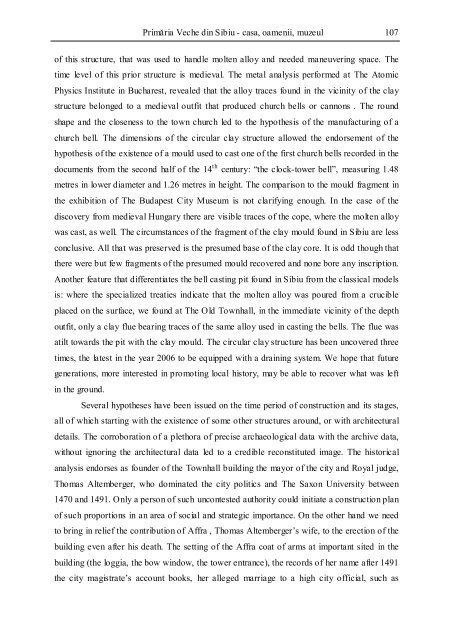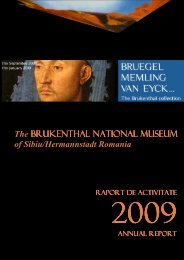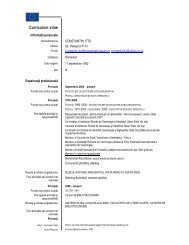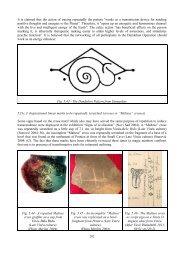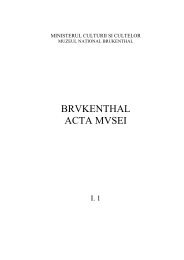PRIMĂRIA VECHE DIN SIBIU casa, oamenii, muzeul
PRIMĂRIA VECHE DIN SIBIU casa, oamenii, muzeul
PRIMĂRIA VECHE DIN SIBIU casa, oamenii, muzeul
Create successful ePaper yourself
Turn your PDF publications into a flip-book with our unique Google optimized e-Paper software.
Primăria Veche din Sibiu - <strong>casa</strong>, <strong>oamenii</strong>, <strong>muzeul</strong> 107<br />
of this structure, that was used to handle molten alloy and needed maneuvering space. The<br />
time level of this prior structure is medieval. The metal analysis performed at The Atomic<br />
Physics Institute in Bucharest, revealed that the alloy traces found in the vicinity of the clay<br />
structure belonged to a medieval outfit that produced church bells or cannons . The round<br />
shape and the closeness to the town church led to the hypothesis of the manufacturing of a<br />
church bell. The dimensions of the circular clay structure allowed the endorsement of the<br />
hypothesis of the existence of a mould used to cast one of the first church bells recorded in the<br />
documents from the second half of the 14 th century: “the clock-tower bell”, measuring 1.48<br />
metres in lower diameter and 1.26 metres in height. The comparison to the mould fragment in<br />
the exhibition of The Budapest City Museum is not clarifying enough. In the case of the<br />
discovery from medieval Hungary there are visible traces of the cope, where the molten alloy<br />
was cast, as well. The circumstances of the fragment of the clay mould found in Sibiu are less<br />
conclusive. All that was preserved is the presumed base of the clay core. It is odd though that<br />
there were but few fragments of the presumed mould recovered and none bore any inscription.<br />
Another feature that differentiates the bell casting pit found in Sibiu from the classical models<br />
is: where the specialized treaties indicate that the molten alloy was poured from a crucible<br />
placed on the surface, we found at The Old Townhall, in the immediate vicinity of the depth<br />
outfit, only a clay flue bearing traces of the same alloy used in casting the bells. The flue was<br />
atilt towards the pit with the clay mould. The circular clay structure has been uncovered three<br />
times, the latest in the year 2006 to be equipped with a draining system. We hope that future<br />
generations, more interested in promoting local history, may be able to recover what was left<br />
in the ground.<br />
Several hypotheses have been issued on the time period of construction and its stages,<br />
all of which starting with the existence of some other structures around, or with architectural<br />
details. The corroboration of a plethora of precise archaeological data with the archive data,<br />
without ignoring the architectural data led to a credible reconstituted image. The historical<br />
analysis endorses as founder of the Townhall building the mayor of the city and Royal judge,<br />
Thomas Altemberger, who dominated the city politics and The Saxon University between<br />
1470 and 1491. Only a person of such uncontested authority could initiate a construction plan<br />
of such proportions in an area of social and strategic importance. On the other hand we need<br />
to bring in relief the contribution of Affra , Thomas Altemberger’s wife, to the erection of the<br />
building even after his death. The setting of the Affra coat of arms at important sited in the<br />
building (the loggia, the bow window, the tower entrance), the records of her name after 1491<br />
the city magistrate’s account books, her alleged marriage to a high city official, such as


